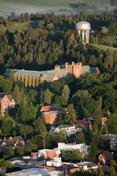伙伴关系的力量
Idaho Forests Managed Best Through Collaboration
A heavily timbered swath of almost 80 square miles of mixed-ownership land in northern Idaho is managed using a model of collaboration that is becoming more common across the landscape.
The Buckskin Saddle project is among more than 21 million acres of forestland in the Gem State where private landowners and state and federal forest managers work side-by-side with industry, conservationists and environmental groups to make a healthier forest.
Forest collaboration initiatives aren’t new, but they are becoming the modus operandi in a state known for its sweeping forest panoramas.
在一个 最近的研究 365滚球官网的研究人员, 研究人员发现, 从计划到完成, collaborative projects required no more time than traditional ones. They treated larger areas and integrated multiple components like watershed restoration, tree thinning and prescribed burns, while building positive relationships around a passionate subject.
“I view collaborations as pretty much necessary to get work done,” said Tom Schultz of Idaho Forest Group, one of the nation’s largest lumber producers.
十年前, 繁文缛节, litigation and environmental hurdles often stymied timber-harvesting in the state where 80% of forest land is publicly owned by the federal government and managed by the U.S. 林务局.
Since collaborations were adopted, 然而, harvesting and timber management projects — especially on federal lands — have seen a steady uptick.
“Collaborative groups have a vested interest in the outcomes, 所以他们解决了这些问题,珍妮·希金斯说, former forest supervisor on the Idaho Panhandle National Forest, home of the Buckskin Saddle project. “Those projects don’t stall or get hung up in litigation.”
In the Nez Perce-Clearwater National Forest, the amount of timber offered for sale recently hit its highest point in nearly three decades. In fiscal year 2020, the forest sold 84.5 million board feet of timber, the most since 1991.
“That doesn’t happen without the support of local communities and counties,” Schultz said.

环保主义者之间的不信任, timber companies and government managers was one of the biggest hurdles to overcome, said John Robison of the Idaho Conservation League.
Conservation groups and timber companies were historically on opposing sides of forest management issues, but a shared concern about forest health and wildfires has brought these groups together.
“Small successes in collaboration led to bigger ones and stakeholders developed confidence in the process and its outcomes,罗宾逊说. “Everyone participates in good faith.”
Forest collaborations include private citizens, area tribes and county commissioners. Like other initiatives, the proposals are presented to the public for review and comment.
有时, partners fill in where there is a need, like the Idaho Department of Lands (IDL) collecting data and developing a plan using resources that a cash-strapped 林务局 doesn’t have.
“We help fill in the gaps,” said Jon Songster, a bureau chief at IDL.
在一个ddition to sharing staff and funding, the 林务局 and IDL belong to a governor-appointed advisory group that identifies management priorities and opportunities for collaboration on Idaho’s forestlands. Projects that are agreed on through collaboration have the best chance of moving forward, said Brad Smith of the Idaho Conservation League.
“The collaborative groups develop recommendations that have the support of the community,史密斯说. “If the 林务局 and the state are responsive to those recommendations, then they can feel confident that the project will move forward.”
本文由 拉尔夫Bartholdt, University 通讯及市场推广.
摄影的 梅丽莎·哈特利, University 通讯及市场推广.
Published in the Spring 2021 issue of 这里是爱达荷州.







